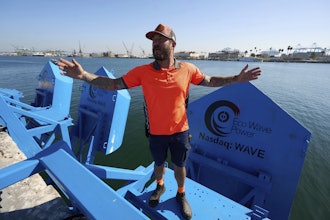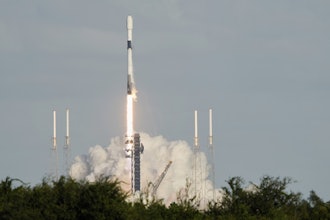Maintenance Robots are the Future
The Wall Street Journal says that factory workers have a new sense of job security, so let's ruin it.
This week, Rolls-Royce offered an exciting new look at the future of engine maintenance. Well, it's exciting to everyone except maybe maintenance professionals.
Rolls-Royce partnered with Harvard University and the University of Nottingham to discuss the role robotics will play in the future of engine maintenance.
The company calls it the IntelligentEngine and the technologies could not only speed inspection and maintenance work, but could also reduce the cost as engines could stay on the aircraft. At the Farnborough Airshow, Rolls-Royce showed off four technologies currently in various stages of development: INSPECT robots, remote boreblending roots, FLARE robots, and SWARM robots.
The INSPECT robots are a network of periscopes that are embedded into the engine to detect any anomalies.
The remote boreblending robots could be an answer to the skills shortage as it's a tool that local teams would install in the engine and then hand over remote access to specialist engineers — and we're talking about mission critical parts, like repairing damages blades with lasers.
The FLARE robots are a pair of snake robots that that work like an endoscope to make patch repairs, and the SWARM robots are a set of small 10-mm robots that would be deployed in the center of an engine, via a snake robot, and perform visual inspections.
Some technologies, like the SWARM robots, are far from a reality, but the remote robot is already being tested. It will be interesting to see if and when these technologies spread to other industries.
Flying Bum Gets Luxurious
The Airlander 10 has been called the world's biggest aircraft, but it is likely most famous for its nickname, the "Flying Bum".
A hybrid of a blimp, helicopter and airplane, the 302-foot Airlander 10 is powered by four 325-hp turbocharged diesel engines and can fly for days at a time. But we haven't heard much from the Flying Bum over the last two years. Other than bad news, like in August 2016 when the blimp-shaped airship sustained damage after a rough landing, or when it broke free of its mooring mast in November 2017 and deflated as a safety precaution.
The aircraft was originally developed for the U.S. military for use in surveillance. However, according to New Atlas, Hybrid Air Vehicles (HAV), the company behind the Flying Bum, is developing a luxury version of the airship aimed at the tourism market.
The company revealed concept photos at the Farnborough International Airshow that were designed by UK-based Design Q. They include glass bottoms, luxury seating throughout a 150-foot passenger cabin, an Altitude Bar, and private bedrooms.
The luxury edition is designed to accommodate 19 passengers at a a time, hopefully not all in the bedroom at the same time.
Engineers Sign Pledge Against Killer Robots
Engineers, scientists, tech leaders and hosts of weekly engineering shows have signed a pledge against killer robots. The statement was signed by 2,400 individuals, including Elon Musk, Toby Walsh, and yours truly who promise to "neither participate in nor support the development, manufacture, trade, or use of lethal autonomous weapons".
The pledge was organized by the Future of Life Institute and released at the 2018 International Joint Conference on Artificial Intelligence in Stockholm.
According to a recent report, the industry employs about 300,000 AI engineers, so either the pledge didn't have good word of mouth, or 99.992% of AI professionals are hellbent on the fall of man.
The issue at hand is killer robots also known, perhaps ironically, as lethal autonomous weapons systems (or LAWS). These are weapons that can identify, target, and kill a person, without a human 'in-the-loop'.
The pledge is a call to governments and leaders to help create a future with laws against LAWS.
Toby Walsh, a professor of artificial intelligence at Australia's University of New South Wales in Sydney, said "We cannot hand over the decision as to who lives and who dies to machines."
Here is the pledge:
Artificial intelligence (AI) is poised to play an increasing role in military systems. There is an urgent opportunity and necessity for citizens, policymakers, and leaders to distinguish between acceptable and unacceptable uses of AI.
In this light, we the undersigned agree that the decision to take a human life should never be delegated to a machine. There is a moral component to this position, that we should not allow machines to make life-taking decisions for which others – or nobody – will be culpable. There is also a powerful pragmatic argument: lethal autonomous weapons, selecting and engaging targets without human intervention, would be dangerously destabilizing for every country and individual. Thousands of AI researchers agree that by removing the risk, attributability, and difficulty of taking human lives, lethal autonomous weapons could become powerful instruments of violence and oppression, especially when linked to surveillance and data systems. Moreover, lethal autonomous weapons have characteristics quite different from nuclear, chemical and biological weapons, and the unilateral actions of a single group could too easily spark an arms race that the international community lacks the technical tools and global governance systems to manage. Stigmatizing and preventing such an arms race should be a high priority for national and global security.
We, the undersigned, call upon governments and government leaders to create a future with strong international norms, regulations and laws against lethal autonomous weapons. These currently being absent, we opt to hold ourselves to a high standard: we will neither participate in nor support the development, manufacture, trade, or use of lethal autonomous weapons. We ask that technology companies and organizations, as well as leaders, policymakers, and other individuals, join us in this pledge.
This is Engineering By Design.






















